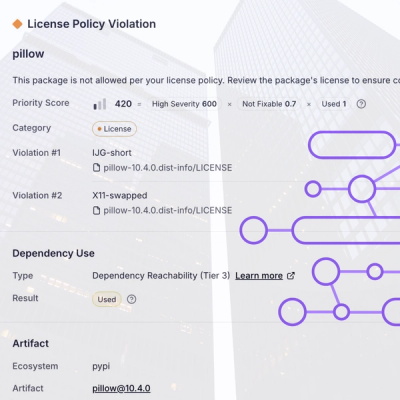
Research
/Security News
Critical Vulnerability in NestJS Devtools: Localhost RCE via Sandbox Escape
A flawed sandbox in @nestjs/devtools-integration lets attackers run code on your machine via CSRF, leading to full Remote Code Execution (RCE).
opentelemetry-instrumentation-httpx
Advanced tools
|pypi|
.. |pypi| image:: https://badge.fury.io/py/opentelemetry-instrumentation-httpx.svg :target: https://pypi.org/project/opentelemetry-instrumentation-httpx/
This library allows tracing HTTP requests made by the
httpx <https://www.python-httpx.org/>_ library.
::
pip install opentelemetry-instrumentation-httpx
Instrumenting all clients
When using the instrumentor, all clients will automatically trace requests.
.. code-block:: python
import httpx
import asyncio
from opentelemetry.instrumentation.httpx import HTTPXClientInstrumentor
url = "https://example.com"
HTTPXClientInstrumentor().instrument()
with httpx.Client() as client:
response = client.get(url)
async def get(url):
async with httpx.AsyncClient() as client:
response = await client.get(url)
asyncio.run(get(url))
Instrumenting single clients
If you only want to instrument requests for specific client instances, you can
use the HTTPXClientInstrumentor.instrument_client method.
.. code-block:: python
import httpx
import asyncio
from opentelemetry.instrumentation.httpx import HTTPXClientInstrumentor
url = "https://example.com"
with httpx.Client() as client:
HTTPXClientInstrumentor.instrument_client(client)
response = client.get(url)
async def get(url):
async with httpx.AsyncClient() as client:
HTTPXClientInstrumentor.instrument_client(client)
response = await client.get(url)
asyncio.run(get(url))
Uninstrument
If you need to uninstrument clients, there are two options available.
.. code-block:: python
import httpx
from opentelemetry.instrumentation.httpx import HTTPXClientInstrumentor
HTTPXClientInstrumentor().instrument()
client = httpx.Client()
# Uninstrument a specific client
HTTPXClientInstrumentor.uninstrument_client(client)
# Uninstrument all clients
HTTPXClientInstrumentor().uninstrument()
Using transports directly
If you don't want to use the instrumentor class, you can use the transport classes directly.
.. code-block:: python
import httpx
import asyncio
from opentelemetry.instrumentation.httpx import (
AsyncOpenTelemetryTransport,
SyncOpenTelemetryTransport,
)
url = "https://example.com"
transport = httpx.HTTPTransport()
telemetry_transport = SyncOpenTelemetryTransport(transport)
with httpx.Client(transport=telemetry_transport) as client:
response = client.get(url)
transport = httpx.AsyncHTTPTransport()
telemetry_transport = AsyncOpenTelemetryTransport(transport)
async def get(url):
async with httpx.AsyncClient(transport=telemetry_transport) as client:
response = await client.get(url)
asyncio.run(get(url))
Request and response hooks
The instrumentation supports specifying request and response hooks. These are functions that get called back by the instrumentation right after a span is created for a request and right before the span is finished while processing a response.
.. note::
The request hook receives the raw arguments provided to the transport layer. The response hook receives the raw return values from the transport layer.
The hooks can be configured as follows:
.. code-block:: python
from opentelemetry.instrumentation.httpx import HTTPXClientInstrumentor
def request_hook(span, request):
# method, url, headers, stream, extensions = request
pass
def response_hook(span, request, response):
# method, url, headers, stream, extensions = request
# status_code, headers, stream, extensions = response
pass
async def async_request_hook(span, request):
# method, url, headers, stream, extensions = request
pass
async def async_response_hook(span, request, response):
# method, url, headers, stream, extensions = request
# status_code, headers, stream, extensions = response
pass
HTTPXClientInstrumentor().instrument(
request_hook=request_hook,
response_hook=response_hook,
async_request_hook=async_request_hook,
async_response_hook=async_response_hook
)
Or if you are using the transport classes directly:
.. code-block:: python
import httpx
from opentelemetry.instrumentation.httpx import SyncOpenTelemetryTransport, AsyncOpenTelemetryTransport
def request_hook(span, request):
# method, url, headers, stream, extensions = request
pass
def response_hook(span, request, response):
# method, url, headers, stream, extensions = request
# status_code, headers, stream, extensions = response
pass
async def async_request_hook(span, request):
# method, url, headers, stream, extensions = request
pass
async def async_response_hook(span, request, response):
# method, url, headers, stream, extensions = request
# status_code, headers, stream, extensions = response
pass
transport = httpx.HTTPTransport()
telemetry_transport = SyncOpenTelemetryTransport(
transport,
request_hook=request_hook,
response_hook=response_hook
)
async_transport = httpx.AsyncHTTPTransport()
async_telemetry_transport = AsyncOpenTelemetryTransport(
async_transport,
request_hook=async_request_hook,
response_hook=async_response_hook
)
OpenTelemetry HTTPX Instrumentation <https://opentelemetry-python-contrib.readthedocs.io/en/latest/instrumentation/httpx/httpx.html>_OpenTelemetry Project <https://opentelemetry.io/>_FAQs
OpenTelemetry HTTPX Instrumentation
We found that opentelemetry-instrumentation-httpx demonstrated a healthy version release cadence and project activity because the last version was released less than a year ago. It has 1 open source maintainer collaborating on the project.
Did you know?

Socket for GitHub automatically highlights issues in each pull request and monitors the health of all your open source dependencies. Discover the contents of your packages and block harmful activity before you install or update your dependencies.

Research
/Security News
A flawed sandbox in @nestjs/devtools-integration lets attackers run code on your machine via CSRF, leading to full Remote Code Execution (RCE).

Product
Customize license detection with Socket’s new license overlays: gain control, reduce noise, and handle edge cases with precision.

Product
Socket now supports Rust and Cargo, offering package search for all users and experimental SBOM generation for enterprise projects.